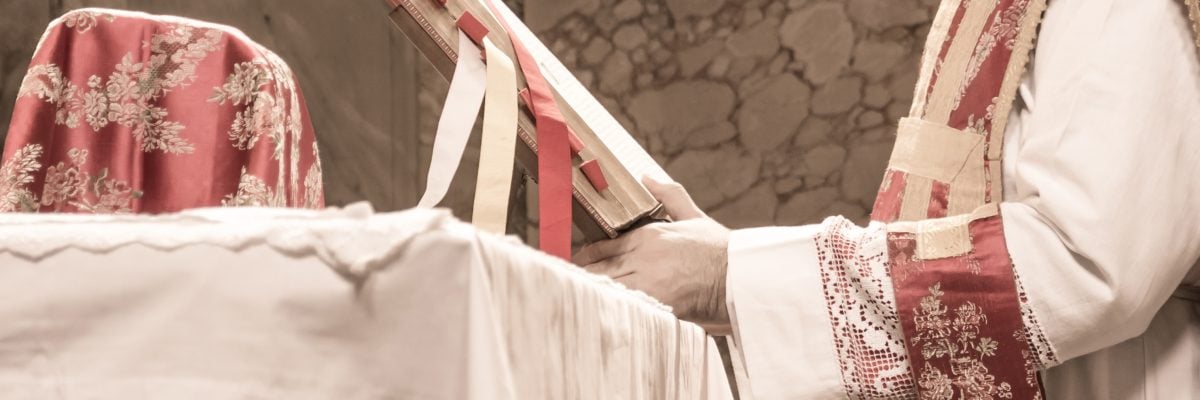
Protestants argue that there is no ministerial priesthood. Instead, they say we’re all priests. As Martin Luther did, they use 1 Peter 2:9 to support this claim: “But you are a chosen race, a royal priesthood, a holy nation, God’s own people.”
Catholics argue that a ministerial priesthood does exist in the New Covenant, apart from the priesthood of all believers. What are we to make of this disagreement? What does the Bible have to say about it?
I’ve addressed this topic before but restricted the evidence to the Last Supper. Tim Staples has provided an assortment of evidence for it as well. Here I want to share with you some additional clues that, although perhaps obscure at first glance, when understood in light of the Old Testament give strong evidence for the existence of a ministerial priesthood in first-century Christianity.
Priestly ranks
Let’s start with 1 Peter 2:9. All agree that this is an allusion to Exodus 19:6, which refers to Israel as “a kingdom of priests and a holy nation.” Peter is obviously drawing a parallel between Israel and the Church.
But, rather than disproving the Catholic position, this verse actually supports it. During the time of Exodus, the universal priesthood of the Israelites was merely one rank (the lowest rank) of priestly status among two others: the top level of Aaron the high priest, and the middle level, which comprised his sons, Nadab, Abihu, Eleazar, and Ithamar, who served with Aaron (see Exodus 28 and Leviticus 8).
When we look in the New Testament we discover a top level there, too: Jesus, our high priest (Heb. 3:1). We’ve already seen that the bottom rank consists of the body of Christian believers (1 Pet. 2:9), in a parallel with the universal priesthood of the Israelites. It makes biblical sense for there also to be a New Testament parallel to the middle rank: ministers specially ordained to serve the people with Jesus just as Aaron’s sons served with him.[1]
Who is the rebellious Korah?
A second obscure clue pointing to this middle rank is Jude’s passing remark that some Christians in the first century had fallen into Korah’s rebellion: “Woe to them! For they walk in the way of Cain, and abandon themselves for the sake of gain to Balaam’s error, and perish in Korah’s rebellion” (Jude 11; emphasis added).
Jude 4 sets the context by stating that there were “ungodly persons who pervert the grace of our God into licentiousness and deny our only Master and Lord, Jesus Christ.” How were these men perverting God’s grace? Whatever they were doing, it was something similar to what Korah did. But who was Korah, and what did he do that was so bad?
Korah was a figure in the Old Testament who, along with many other Israelites, rebelled against the authority of Moses and the Aaronic priesthood (see Numbers 16 for the whole story). Korah and his followers rejected the hierarchy of the Aaronic priesthood, claiming themselves to be of the same rank. We get a hint of this in Numbers 16:8,10-11: “And Moses said to Korah…would you seek the priesthood also? Therefore it is against the LORD that you and all your company have gathered together.”
In response, Moses proposed a challenge, which consisted of Korah and the other rebels filling their censers with incense while Aaron did the same, and seeing whose offering the Lord would accept. The Lord rejected the offering of Korah and his followers, making the mouth of the earth open up and swallow them into Sheol (16:32).
Moses had the censers hammered out and made into a covering for the altar as “a reminder to the people of Israel, so that no one who is not a priest, who is not of the descendants of Aaron, should draw near to burn incense before the Lord, lest he become as Korah and as his company” (v.40).
Notice that the warning here was not only against those who would object to Aaron as high priest, but also to those who would object to the priestly rank of “the descendants of Aaron.” God was not only serious about the top-level rank of the high priest, but also the middle level of his ministerial priests.
It is against this Old Testament backdrop that we must read Jude 11 and its mention of some early Christians participating in Korah’s rebellion. If “Korah’s rebellion” was present within the first-century Christian community, there must have existed a priesthood, above the universal priesthood, to rebel against.
Old and new priestly prerogatives
We can add to the batch of clues Jesus’ defense of the apostles’ picking heads of grain to eat on the Sabbath (Matt. 12:1-8). The Pharisees objected, because they viewed the apostles’ behavior as breaking the Sabbath rest. Jesus responded by recalling how David and his men ate the showbread (bread of presence) within the Holy Place (in 1 Sam. 21) as part of their priestly Sabbath duty (see Lev. 24:8-9).
Jesus then reminds the Pharisees of the priestly prerogative of breaking the Sabbath rest in order to offer sacrifices in the temple: “[H]ave you not read in the law how on the Sabbath the priests in the temple profane the Sabbath, and are guiltless?”
By appealing to the Old Testament priestly prerogative of breaking the Sabbath rest without incurring the guilt of sin, perhaps Jesus is subtly showing that his apostles are New Covenant priests who enjoy the same priestly prerogative. And if this is so, then it’s true to say that Jesus established a ministerial priesthood distinct from the universal.
Let the light shine
Biblical authors sometimes make passing references to things that seem to us superfluous or unimportant. But usually, all we need is a little Old Testament light to be shined upon such details. As the saying goes, “We must read the New in light of the Old, and the Old in light of the New.”
As Bible-loving Christians, we Catholics join Protestants and profess the biblical truth that we are all “a royal priesthood” (1 Pet 2:9). But our love for the Bible also leads us to conclude that Jesus also established a priestly rank over and above the priesthood of believers: just like there was in the Old Testament, and just as we find today in the Catholic Church.
[1] Worth noting here is that in Catholic theology the Old Testament high priesthood correlates with the bishop, as well, because he participates in Jesus’ priestly ministry in the fullest degree (CCC 1586).



